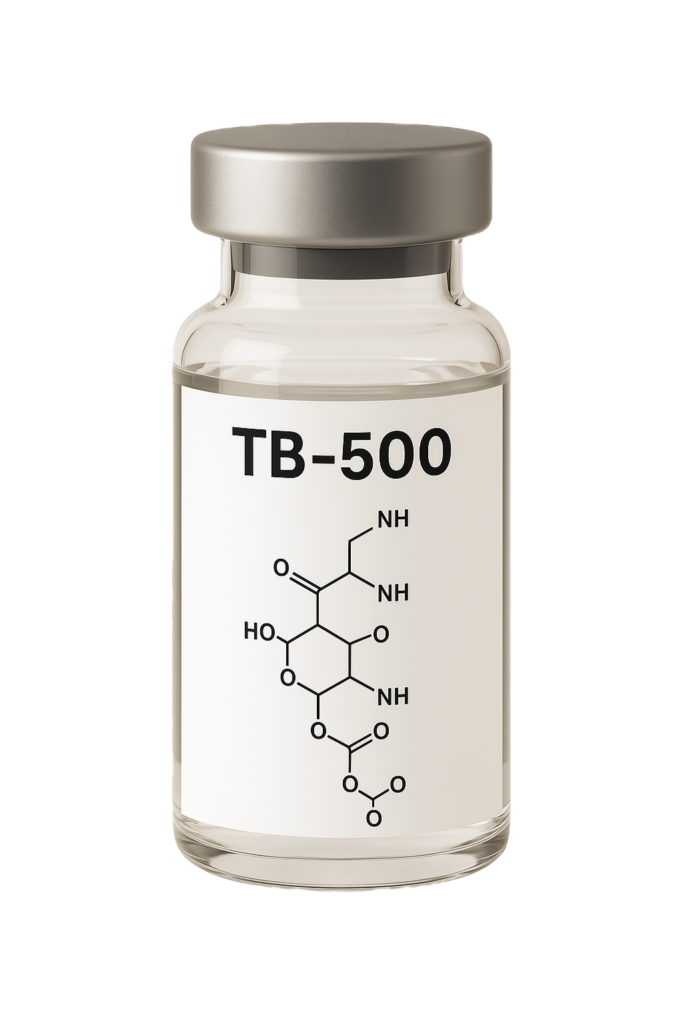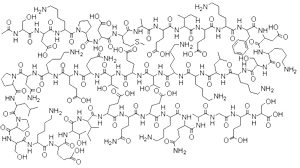TB-500
Inflammation reduction
Angiogenesis studies
Cell migration research
TB-500 is a synthetic peptide modeled after thymosin beta-4, a naturally occurring protein involved in tissue repair and regeneration. It is primarily studied for its potential to accelerate healing processes, reduce inflammation, and promote cellular migration.
Mechanism of action
TB-500 functions by upregulating actin, a protein crucial for cell structure and movement. By enhancing actin production, it facilitates cell migration, angiogenesis (formation of new blood vessels), and tissue regeneration. Its low molecular weight allows it to travel efficiently through tissues, targeting areas of injury.
Notable Studies
Research indicates that TB-500 promotes wound healing and reduces inflammation in animal models.
Studies have shown its potential in improving muscle fiber regeneration and collagen structure, leading to enhanced tissue repair.
Risk Associated
TB-500 is not approved by the FDA for human use, and its safety profile is not fully established. Potential risks include:
Unregulated production leading to purity concerns
Lack of comprehensive clinical trials
Potential side effects such as fatigue, dizziness, and injection site reactions
Dosage
In research settings, TB-500 is typically administered via subcutaneous injection. Dosages vary based on study design, and there is no standardized dosing regimen established. Researchers should consult relevant studies and protocols when determining appropriate dosages.
External link


TB-500
Inflammation reduction
Angiogenesis studies
Cell migration research
Mechanism of action
TB-500 functions by upregulating actin, a protein crucial for cell structure and movement. By enhancing actin production, it facilitates cell migration, angiogenesis (formation of new blood vessels), and tissue regeneration. Its low molecular weight allows it to travel efficiently through tissues, targeting areas of injury.
Risk
Associated
TB-500 is not approved by the FDA for human use, and its safety profile is not fully established. Potential risks include:
Unregulated production leading to purity concerns
Lack of comprehensive clinical trials
Potential side effects such as fatigue, dizziness, and injection site reactions
Notable Studies
Research indicates that TB-500 promotes wound healing and reduces inflammation in animal models.
Studies have shown its potential in improving muscle fiber regeneration and collagen structure, leading to enhanced tissue repair.
Dosage
In research settings, TB-500 is typically administered via subcutaneous injection. Dosages vary based on study design, and there is no standardized dosing regimen established. Researchers should consult relevant studies and protocols when determining appropriate dosages.
External link
TB-500
Inflammation reduction
Angiogenesis studies
Cell migration research
Mechanism of action
TB-500 functions by upregulating actin, a protein crucial for cell structure and movement. By enhancing actin production, it facilitates cell migration, angiogenesis (formation of new blood vessels), and tissue regeneration. Its low molecular weight allows it to travel efficiently through tissues, targeting areas of injury.

Risk
Associated
TB-500 is not approved by the FDA for human use, and its safety profile is not fully established. Potential risks include:
Unregulated production leading to purity concerns
Lack of comprehensive clinical trials
Potential side effects such as fatigue, dizziness, and injection site reactions
Notable Studies
Research indicates that TB-500 promotes wound healing and reduces inflammation in animal models.
Studies have shown its potential in improving muscle fiber regeneration and collagen structure, leading to enhanced tissue repair.
Dosage
In research settings, TB-500 is typically administered via subcutaneous injection. Dosages vary based on study design, and there is no standardized dosing regimen established. Researchers should consult relevant studies and protocols when determining appropriate dosages.
External link
-
TB-500 Peptide: Benefits, Mechanism, and Healing Properties.
-
TB-500 | Reviews, Clinical Trials, and Safety.
-
TB-500 Exposed: The Risks Outweigh the Benefits.